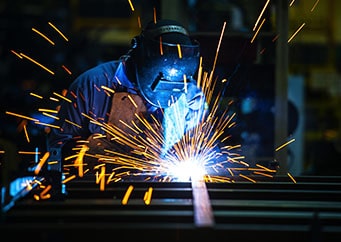The importance of dust collection can’t be underestimated when your life is in danger.
Dust collection has become an important issue in many industries that must produce raw materials, such as metalworking or wood pellet manufacturing. The importance of dust collection cannot be understated, especially since employers must now abide by OSHA standards for dust procedures.
What are the dangers of dust? Dust accumulates in the produced material during operations and because of its large quantity and combustible properties, may become a fuel—leading to accidental fires and explosions. The combustible nature of dust has made it hazardous in work environments as we have seen through several unfortunate incidents in factories around the US documented over the past 10 years. OSHA defines combustible dusts as “fine particles that present an explosion hazard when suspended in air in certain conditions.”
Dust that accumulates at wood pellet plants during the production process can end up being a fuel source itself, fueling unwanted fires or explosions. Effective dust management must be an integral aspect of all manufacturing plants as a continual prevention process. “Essentially we are taking a woody product, reducing its particle size and drying it into its most combustible form, and then densifying it afterward,” says Shawn Bells, general manager with Pacific BioEnergy. “So with regard to what we do, we’re probably doing the exact opposite of what you are supposed to be doing—we are creating a fuel—so then we have to deal with it.”
Producers understand now that their operations must be governed strictly by dust control and management in order to abide by OSHA. President of American Wood Fibers Stephen Faeher explains that this increased awareness became prominent around 10 years ago. “OSHA became focused on dust control and management. That’s, I think, when it heightened everyone’s awareness.”
What is OSHA?
 The Occupational Safety and Health Administration governs employment safety by providing employers with hazard-specific safety and health standards. The Occupational Safety and Health Act requires that employers comply with health standards given by OSHA or a state-approved plan. The General Duty Clause of the Act (Section 5 (a) (1)) requires that employers maintain a work environment free from recognized hazards which could cause serious harm or death.
The Occupational Safety and Health Administration governs employment safety by providing employers with hazard-specific safety and health standards. The Occupational Safety and Health Act requires that employers comply with health standards given by OSHA or a state-approved plan. The General Duty Clause of the Act (Section 5 (a) (1)) requires that employers maintain a work environment free from recognized hazards which could cause serious harm or death.
What Causes Dust Explosions?
 The importance of dust collection as a preventative measure is seen in the FIRE TRIANGLE: the elements needed for a fire. In our case, dust comprises the “fuel”:
The importance of dust collection as a preventative measure is seen in the FIRE TRIANGLE: the elements needed for a fire. In our case, dust comprises the “fuel”:
- Combustible dust (fuel)
- Ignition source (heat)
- Oxygen in air (oxidizer)
In addition, a dust explosion is more likely when the dust cloud is ignited within a confined area. When that dust is further dispersed, this can cause an even more severe second explosion. This may occur after the first explosion shakes fugitive dust into other places. If you have had the warning of a first explosion, be sure to watch out. A second explosion can be more dangerous and create more widespread damage than the first.
The Employer’s Responsibility for Worker Safety
One of the most effective ways to prevent explosions is to train employees to recognize the warning signs of combustion. The importance of training the people closest to the hazard cannot be underestimated, as they can be instrumental in sighting unsafe conditions and calling on management.
Though the OSHA regulations necessitate that certain employees be trained, it is recommended that employers issue basic education on the importance of dust collection and combustion prevention procedures. Such education should include information on plant programs on dust management and ignition source controls. The training should be required in these circumstances:
- Pre-assignment training
- Periodic refreshers-i.e. every 6 month re-licensure for work in these environments
- Re-assignment training-i.e. any time work location changes, employees should receive information correspondent to that area

Training should include a practical as well as a lecture aspect. All lectures should be followed or accompanied by demonstrations of the procedures, and as much as possible, employees should be asked to repeat the procedure for the practical element. Repeating the procedure under supervision with feedback given for each practice re-enforces the most important tasks and ensures that employees have absorbed the detail given by the lectures.
It should also be noted that employers holding hazardous chemicals, which includes combustible dusts, must comply with the Hazard Communication standard, 29 CFR 1910.1200.. Included in this regulation is the law that all containers of hazardous chemicals must have labels on them, and the requirement to provide employee training.
Case Study of Dust Fire and Explosion: Massachusetts (3 killed, 9 injured)
 In 1999 there was a deadly fire explosion in a foundry in Massachusetts which killed 3 and injured 9 employees. The Occupational Safety Health Administration (OSHA), supported by state and local officials, conducted an investigation of the happening to determine its causes.
In 1999 there was a deadly fire explosion in a foundry in Massachusetts which killed 3 and injured 9 employees. The Occupational Safety Health Administration (OSHA), supported by state and local officials, conducted an investigation of the happening to determine its causes.
It was discovered that the fire commenced within a shell molding machine and continued into ventilation systems, fueled by deposits of phenol formaldehyde resin dust. The small fire initiated within the ductwork and dislodged dust sitting on outside of the ducts. This caused a dust cloud to formulate, causing a second explosion (as explained above). The investigation concluded that the following were necessary to prevent such explosions in the future:
- Housekeeping to manage dust accumulation
- Ventilation system design
- Oven maintenance
- Equipment of safety devices
 This case study shows the necessity for laws surrounding the proper use and disposal of dust types. Other incidences of dust explosions have still been common since 1999, as most standards of national and international safety bodies have been only recommended. But in 2003 alone, there were three dust explosions that caused 14 deaths. The US Chemical Safety & Hazard Investigation Board launched a study of industrial dust explosions.
This case study shows the necessity for laws surrounding the proper use and disposal of dust types. Other incidences of dust explosions have still been common since 1999, as most standards of national and international safety bodies have been only recommended. But in 2003 alone, there were three dust explosions that caused 14 deaths. The US Chemical Safety & Hazard Investigation Board launched a study of industrial dust explosions.
From 1980 to 2005 there were 281 dust fires in US businesses, causing 119 deaths that could have been prevented. Clearly, dust accumulation and dispersion is a problem that continues to plague production facilities—confirmed by the fact that since the 2003 investigation, 70 more dust fires have taken place within US businesses.
Where are companies going to ensure that their facilities are safe for the worker? What combination of dust protection products and employee training are being used to guard against fires? How are you seeking to prevent dust explosions from occurring in your facilities?
Professional Dust Collection and Management Services
If what you have read thus far is ringing alarm bells for you, you may need dust and fume collection equipment to guard your employees’ safety and the livelihood of your company assets. Over the past ten years, Imperial Systems has provided manufacturers the most advanced and reliable equipment for prevention of dust-induced explosions.
We manufacture all our materials from our own store in western Pennsylvania, so that we can ensure that you have the most quality product possible. We offer the following products:

- CMAXX Dust Collector System
- DeltaMAXX Cartridge Filters
- CMAXX Laser Fume Extraction System
- Heavy Duty Abort Gates
- Airlocks
- Backdraft Damper
- SCF Dust Collectors
- Diverter Valves
- Spark Arrestor
- Lidegates
- Flex hose
We hope that our research on the importance of dust collection and process maintenance has been helpful to you as you seek to instill the best practices in your company. At Imperial Systems, we want to bring true value to your company’s systems by using our expertise in the industry and our unique, “home-made” products. We thus hope to be a resource to you as you figure out what your needs are and how best to follow OSHA regulations as summarized above.
For now, we leave you with the question: When was the last time you checked your dust collection processes? Are all your boxes checked in the areas of housekeeping (dust accumulation removal), proper ventilation, safety equipment, and oven maintenance? How often are your employees trained, and are they receiving all the information they need to prevent dust explosions in your manufacturing plant? Don’t hesitate to call us with any questions.
